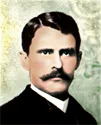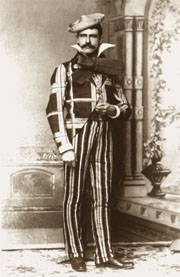Orville Gibson
Orville H. Gibson was born in 1856 on a farm near the small town of Chateaugay, New York, in an area known as “Earlville,” about one hour north of Lake Placid and about an hour south of Montreal. The youngest child of John W. and Amy Nichols Gibson, Orville was one of five children sharing a home with sisters Pluma and Emma, and brothers Ozro and Lovell. John, Orville’s father, was an immigrant of England and his mother Amy was from Peru, New York.
It is unclear why Orville travelled from his home in upstate New York to Michigan, but records indicate his concerns about health and well being, and it is possible that he may have been drawn initially to Battle Creek to seek therapy at a world-famous health spa run by Dr. John Harvey Kellog. Regardless of the reasons for his move, by 1890 he ended up in Kalamazoo, a small industrial city in the southwestern part of the state where he took up the hobby of making musical instruments. In 1885, Orville had a job as a clerk at A.P. Sprague’s shoe store at 118 East Main Street, and by 1893 he was working as a clerk at Butters Restaurant on 216 East Main. His day jobs were supporting his hobby, and his hobby was soon to play a totally different role in his life.
On May 11, 1896, Orville filed for his first and only patent. That document, U.S. Patent No. 598,245, was issued on February 1, 1898 and contained his ideas for the construction of a mandolin with a carved top and back, and with sides that were cut from a solid piece of wood rather than being bent from thin strips. Orville felt that the bent and multi-pieced back of the then popular bowl-back mandolins did not possess “that degree of sensitive resonance and vibratory action necessary to produce the power and quality of tone and melody found in” his instruments. A further embellishment of his patent was that the heel of the neck was hollowed out to provide an additional sound chamber which he hoped would offer improved tonal qualities.
Orville’s earliest instruments were quite unusual and featured carved soundboards, black painted surfaces, elaborate inlays, and rims (“ribs”) cut from a solid piece of wood rather than being bent into their final shape.
During the following years, Orville continued to make instruments in his meager shop. Early in 1900, he met several businessmen who wanted an opportunity to manufacture mandolins and guitars of his design, and to do so under the protection of Orville’s singular patent.
Inside the soundhole of Gibson’s early instruments can be found a wonderful array of labels, each which tells a story of its own. The “lyre label” boasted a picture of Orville and what appears to be a lyre.
On the afternoon of October 11, 1902, Sylvo Reams, Lewis A. Williams (for more on Lewis, see Lloyd Loar), LeRoy Hornbeck, John W. Adams, Samuel K. VanHorn, and Orville H. Gibson met at the County Clerk’s office to form a “Partnership Limited Association” (fundamentally, a business structure in which various investing members had limited liabilities) for the “Gibson Mandolin-Guitar Manufacturing Co., Limited.” Adams, VanHorn, and Hornbeck were lawyers practicing in Kalamazoo. Reams and Williams were both in the retail music business, and all saw the opportunity to capitalize on Orville’s creative talents.
Strangely, Orville’s name was not listed as a member of the Partnership — he was at the meeting to sell his patent rights and to formally agree to the terms and conditions of the new organization. In 1904, another agreement followed which documented the payment of $2,500 from the Partnership to Orville Gibson for the exclusive rights to his patent. Through this arrangement, Orville sold his rights for a sum that would be equal to approximately $250,000.00 today.
This photo of Orville has received wide attention. Among the most interesting aspects is that it demonstrates Orville playing a slotted-peghead classical guitar, left-handed — an attribute that might account for Orville’s instruments having pickguards that go completely across the instrument’s face to accommodate both right- and left-handed musicians. Further, realizing Orville’s familiarity with the guitar, he was obviously well-versed in guitar construction when he developed his designs for a carved top and carved back instrument with a solid rim. I discovered Orville’s left-hand attribute while looking at prints made from the original tintypes — an early photographic process that resulted in images being “flopped.” The parting of Orville’s hair and the buttoning of his suit verified that he was a lefty (contrary to “flopped” copies of this photo in Jullius Bellson’s books which depicted Orville as right-handed). Julius was the first to know, and we shared many a laugh over this discovery. (The photo, originally black and white, has been hand-colored.)
Beyond the sale of his patent, Orville’s contribution to the Gibson Company in the following few years is unclear, but it does appear that there was question about the quantity and quality of time he spent at the plant. Within a short period after the foundation of the company, the Board passed a motion that “O. H. Gibson be paid only for the actual time he works for the Company.” After that time, the records do not clearly indicate whether he was a full-time employee, a consultant, or just an occasional visitor to the factory.
When the Company began raising capital to fund its growth and development, one of the first investors was Orville Gibson himself — he purchased 60 shares of stock in the company of his own name on November 1, 1902.
Orville continued his arms-length association with the Company through 1907 earning most of his income from royalties. He worked on various projects as an inventor and for a period of time, was even listed in the town directory as a music teacher. In 1908, the Board agreed to pay Orville an annual fee of $500 (equating to a value of about $50,000, today). The payment of $2,500 was to be made in installments of $41.99 per month, (which actually totaled $503.88 per year).
But Orville’s health was deteriorating during the time the Company was getting underway. Various medical records suggest that he was suffering from a chronic disease, loss of weight, and possibly a mental illness. According to State records, Orville had “delusions of persecution” and envisioned that “different persons were trying to get at him.” In one instance, Orville claimed that Sylvo Reams, one of the five businessmen who purchased the company from Orville, kept stressing to him that a phonograph machine could be coupled with a [silent] motion picture machine. (Imagine that!). At the request of Orville’s brother, Ozro, Orville was admitted to Kalamazoo Hospital for extended periods in 1907 to 1909 for psychological treatment. As a result of Orville’s diminished mental capacity, the Attorney General of the State of Michigan assigned William R. Fox to be Orville’s guardian to manage Orville’s personal and financial matters. Upon release from the Kalamazoo Hospital, Orville moved back to New York State and settled in the town of Saranac Lake, where he lived at 24 Ampersand Avenue for a period of about two years. Here he claimed that by moving to Saranac Lake, his health improved and that his “weight improved from 105 pounds [when he left Kalamazoo] to 150 pounds,” much of which he attributed to healthier living and the reduction of stress caused by people and problems that plagued him when he was in Kalamazoo. In 1911 Orville moved further north to Ogdensburg, N.Y. There he was in the care of a Dr. Madill in Franklin County, in 1911. He was treated at the St. Lawrence State Hospital in Ogdensburg (on the St. Lawrence River, about 80 miles west of Chateaugay), and discharged after eight days on August 26, 1911. He returned to the hospital in 1916 and was discharged after another six days of care.
One can only wonder if Orville’s unusual thought process might have influenced his equally unusual instrument designs.
There has been much supposition about this photo of Orville (left) in costume. And one could surmise that he was involved with one or more of the early bands who entertained in similar garb during this period (right).
It is not known whether Orville returned to Kalamazoo, his instrument work, or the company that bore his name during the period of 1911 to 1918. On August 21, 1918, at 10:10am, Orville H. Gibson died of a disease diagnosed as chronic endocarditis. He succumbed while a patient at the St. Lawrence State Hospital, then a hospital for major diseases (today known as the St. Lawrence Psychiatric Center – an institution for mental care). Orville’s funeral services, followed by his burial, were held on August 22, 1918. His death certificate indicates his occupation as “musician.”
Orville was buried in his brother Lovell’s family plot, along with several other Gibsons, in Morningside Cemetery in Malone, about 30 miles from his birthplace. There, on a grassy knoll overlooking a peaceful lilly pond, a small square stone says only “O. H. Gibson, 1856-1918” and marks the resting place of this giant who planted a musical seed for so many of us to enjoy.
It is clear that Orville had little to do with the development of the Gibson banjo line. However, the leading members of the Company obviously were aware of the new interest in banjo that was occurring at the time, and made every attempt to get their fair share of that new market.












